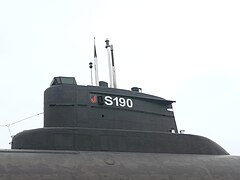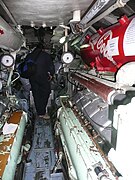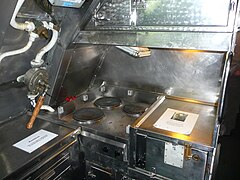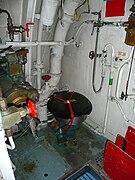Class 205 submarine
|
|
|
|---|---|
| Class 205 | |
 U1 in action, 1967 |
|
| Overview | |
| Type | Coastal submarine |
| units |
|
| Shipyard |
HDW , Kiel |
| Order | December 12, 1960 |
| Technical specifications | |
| displacement |
450 t surfaced |
| length |
45.7 m |
| width |
4.6 m |
| height |
9.2 m |
| Draft |
4.0 m (surfaced) |
| crew |
22nd |
| drive |
2 diesel generators each with 1 Mercedes-Benz 12-cylinder 4-stroke V-diesel engine 600 hp and a firmly coupled BBC generator (the diesel generators have no connection to the screw shaft ) 1 SSW electric drive motor 1,100 kW / 1,500 hp acting on one Shaft with 5- (class 205) / 7- (class 205 B) leaf screw |
| speed |
10 kn surfaced |
| Armament |
8 × 533 mm torpedo tubes also for mines (RI + II) |
The class 205 submarines were the first successful series submarines of the German Navy after the Second World War .
Tasks and commitment
The class 205 submarines were used to combat enemy warships in the Baltic Sea . In the event of war, they were assigned an important role in repelling attacks with landing craft against the NATO area in the area of the Baltic Sea accesses.
Between 1967 and 2004 the boats operated mainly in the North and Baltic Seas. U 12 went out of service as a test vehicle for new weapon systems on June 21, 2005 as the last German boat.
Two class 205 submarines were built for the Danish Navy .

Technology and development
Submarine building program
At the beginning of the development of the German Navy in 1956, several submarine classes had been commissioned, including twelve coastal submarines of class 201 . Even during the construction of these boats, there were considerable additional military demands, which led to a revision of the design. From the fourth boat in the series, the adjustments were implemented, and the modified boats were given the designation class 205 .
Nine class 205 submarines were commissioned from Kieler Howaldtswerke on December 12, 1960 . The Lübeck engineering office under Ulrich Gabler was responsible for construction and development . Two other boats were built on the Orlogsværft in Copenhagen under license for the Danish Navy and put into service under the names Narhvalen and Nordkaperen .
In the class 201 boats it soon became apparent that the steel used was unsuitable, and the series was canceled after the third boat ( U 1 , U 2 , U 3 ). This so-called steel crisis also affected the class 205 U 4 to U 8 boats that were already under construction or completed .
Variants of class 205
As a consequence of the steel crisis, a construction freeze was imposed on the other boats in order to be able to select a suitable steel. This results in different variants of class 205.
U 4 to U 8
The boats U 4 to U 8 were so far completed when the steel crisis occurred that the Navy decided against demolishing the construction. Various measures have been tried to reduce the corrosion problems. The boats were given plastic paint, spray galvanization and additional sacrificial anodes . However, these measures were not enough to resolve the problem. In order not to delay the construction of the submarine weapon any further, the boats were used exclusively as school boats for the submarine teaching group in Neustadt-Holstein. Their torpedo tubes were sealed, and their use was subject to special safety restrictions. All boats were decommissioned and scrapped in 1974 after the addition of class 206 .
U 9 to U 12
The last four boats in class 205 were made of three different non-magnetizable steels. For U 9 and U 10 , grade AM 53 steel from the Austrian manufacturer Schoeller-Bleckmann Stahlwerke was used , which had also supplied the AM 10 and AM 20 grade steel for class 201. U 11 was built from PN 18 S2 (1.3964) from Phoenix-Rheinrohr-Stahl , and U 12 was built from Amanox 182 M 9 from Stahlwerke Südwestfalen . The PN 18 S2 , which has since been used for the construction of all later German submarines, has proven itself best .
U 1 and U 2
U 1 and U 2 have been completely converted into class 205 boats and are in fact new builds. Instead of a non-magnetizable steel, ferritic shipbuilding steel St 52 was used. On U 1 were 1963 and 1966, i. H. in the two variants 201 and 205 made experiments with a stern torpedo tube.
Later modifications
Towards the end of their active service time and afterwards three boats of the class 205 were converted and used for various tests.
- U 1
U 1 was converted in 1987 at HDW in Kiel to test the fuel cell drive. This successful sea test then formed the foundation for the installation of the fuel cell drive in the later class 212 . After decommissioning in 1991, it was transferred to Thyssen Nordseewerke in Emden as a test vehicle for further submarine drives that are independent of the outside air, where it was equipped with a closed-circuit drive .
- U 11
U 11 received an additional outer skin in order to be used as a target ship for torpedo shooting exercises. Since 2005 the boat can be viewed as the Fehmarn submarine museum in the port of Burgstaaken .
- U 12
U 12 was converted as a test vehicle for a towing sonar and carried such a device for several years.
Technical specifications
- Equipment:
- Withdrawable devices:
- Periscope
- Rod antenna
- Radar mast
- snorkel
- ECM (radar detection)
- UHF antenna
- Withdrawable devices:
- Nominal diving depth: 100 m with a safety factor of 2.5
- Range: approx. 4200 nm at 5 kn above water, approx. 228 nm at 4 kn submerged
- Construction costs: approx. DM 25 million
Units & whereabouts
| Identifier | Surname | version | Keel laying | Launch | Commissioning | unit | Decommissioning | Whereabouts |
|---|---|---|---|---|---|---|---|---|
| S183 | U 4 | 1. Construction lot (steel AM 10) |
April 1, 1961 | August 25, 1962 | November 19, 1962 |
1st submarine squadron in Kiel submarine teaching group in Neustadt |
1st August 1974 | scrapped |
| S184 | U 5 | 1. Construction lot (steel AM 10) |
June 1, 1961 | November 20, 1962 | 4th July 1963 |
1st submarine squadron in Kiel submarine teaching group in Neustadt |
17th May 1974 | scrapped |
| S185 | U 6 | 1. Construction lot (steel AM 10) |
November 8, 1961 | January 30, 1963 | July 24, 1963 |
1st submarine squadron in Kiel submarine teaching group in Neustadt |
22nd August 1974 | scrapped |
| S186 | U 7 | 1. Construction lot (steel AM 10) |
February 1, 1962 | April 10, 1963 | March 16, 1964 May 22, 1968 |
1st submarine squadron in Kiel submarine teaching group in Neustadt |
September 30, 1965 July 12, 1974 |
scrapped |
| S187 | U 8 | 1. Construction lot (steel AM 10) |
20th February 1963 | June 19, 1963 | July 22, 1964 |
1st submarine squadron in Kiel submarine teaching group in Neustadt |
October 9, 1974 | scrapped |
| S180 | U 1 | 2. Construction lot (steel St 52) |
February 1, 1965 | 17th February 1967 | June 26, 1967 | 1st submarine squadron in Kiel | November 29, 1991 | scrapped |
| S181 | U 2 | 2. Construction lot (steel St 52) |
September 1, 1964 | July 15, 1966 | October 11, 1966 | 1st submarine squadron in Kiel | March 19, 1993 | scrapped |
| S188 | U 9 | 2. Construction lot (Stahl AM 53) |
December 10, 1964 | 20th October 1966 | April 11, 1967 | 1st submarine squadron in Kiel | 3rd June 1993 | Museum in Speyer |
| S189 | U 10 | 2. Construction lot (Stahl AM 53) |
July 15, 1965 | 5th June 1967 | November 28, 1967 | 1st submarine squadron in Kiel | February 16, 1993 | Museum in Wilhelmshaven |
| S190 | U 11 | 3. Construction lot (steel PN 18 S2) |
April 1, 1966 | February 9, 1968 | June 21, 1968 | 1st submarine squadron in Kiel later in Eckernförde | October 30, 2003 | Museum in Burgstaaken |
| S191 | U 12 | 3. Construction lot (steel Amanox 182 M 9) |
September 1, 1966 | September 10, 1968 | January 14, 1969 | 1st submarine squadron in Kiel later in Eckernförde | June 21, 2005 | scrapped |
| Identifier | Surname | version | Keel laying | Launch | Commissioning | unit | Decommissioning | Whereabouts |
|---|---|---|---|---|---|---|---|---|
| S320 | KDM Narhvalen | 3. Construction lot | February 16, 1965 | September 10, 1968 | February 27, 1970 | 5th Squadron in Frederikshavn | October 16, 2003 | scrapped |
| S321 | KDN Northern Cape | 3. Construction lot | March 4th 1966 | 18th December 1969 | December 22, 1970 | 5th Squadron in Frederikshavn | February 2, 2004 | scrapped |
The tower of one of the two Danish boats came back to Germany in 2019 and is exhibited in a private museum in Beneckenstein.
History of boats
U 4 (S183)
The first unit of class 205 was U 4 (S183), which was started as a class 201 boat but was launched with the modified design of class 205. It was put into service in 1962 by Kapitänleutnant Bringewat, who had previously led U Hecht .
| Rank | Surname | from | to |
|---|---|---|---|
| Lieutenant captain | Bringewat | November 19, 1962 | March 1964 |
| First lieutenant | from Steynitz | April 1964 | September 1966 |
| First lieutenant | Hans Schäfer | January 1967 | September 30, 1968 |
| Lieutenant captain | Poppe | 1st October 1968 | September 30, 1970 |
| Lieutenant captain | Hoschatt | 1st October 1970 | 22nd August 1971 |
| Lieutenant captain | Hans Lüssow | 23rd August 1971 | December 31, 1971 |
| Lieutenant captain | Becker | January 1, 1972 | October 9, 1972 |
| Lieutenant captain | Sat | October 10, 1972 | 2nd November 1973 |
| Lieutenant captain | Poske | 3rd November 1973 | 7th January 1974 |
| Lieutenant captain | fracture | January 8, 1974 | August 8, 1974 |
U 5 (S184)
| Rank | Surname | from | to |
|---|---|---|---|
| Lieutenant captain | W. Wüstenberg | 4th July 1963 | January 15, 1964 |
| First lieutenant | Contactor | January 16, 1964 | February 28, 1964 |
| First lieutenant | Ullmann | January 29, 1964 | March 26, 1964 |
| First lieutenant | ED Jung | March 27, 1964 | December 6, 1965 |
| Lieutenant captain | Lurking | December 7, 1965 | July 14, 1968 |
| Lieutenant captain | Wilhelms | 15th July 1968 | 15th January 1970 |
| Lieutenant captain | Ewald | January 16, 1970 | December 31, 1970 |
| Lieutenant captain | Nietmann | 1st January 1971 | 2nd October 1972 |
| Lieutenant captain | Shower weather | 3rd October 1972 | 17th May 1974 |
U 6 (S185)
The commissioning of U 6 (S185) took place in 1963, simultaneously with that of U 5, by Lieutenant Captain Hans-Jochen Emsmann, a former commander of U Hai .
| Rank | Surname | from | to |
|---|---|---|---|
| Lieutenant captain | Hans Jochen Emsmann | 4th July 1963 | September 30, 1965 |
| First lieutenant | Peter Jung | October 1, 1965 | December 31, 1967 |
| First lieutenant | Holfert | 1st January 1968 | 22nd September 1968 |
| Lieutenant captain | Dirk Horten | 23rd September 1968 | December 31, 1968 |
| First lieutenant | Behrens | 1st January 1969 | August 11, 1971 |
| First lieutenant | fracture | August 12, 1971 | September 30, 1971 |
| Lieutenant captain | Hillebrenner | 1st October 1971 | September 30, 1972 |
| Lieutenant captain | Bischoff | 1st October 1972 | September 30, 1973 |
| Lieutenant captain | Shitty | 1st October 1973 | 22nd August 1974 |
U 7 (S186)
U 7 was in 1964 by first lieutenant z. S. Hannes Ewerth, the son of frigate captain Klaus Ewerth (commander of U 850 ) put into service. Ewerth later became the commander of the U-Flotilla . In the following year, a battery explosion occurred on board U 7, as a result of which the boat had to be decommissioned and repaired. The relatively wide tower cladding of the first boats in class 205 (U 4 to U 8) was replaced by the more aerodynamic version of the improved class 205 (U 9 and following). However, U 7 did not get its structure on the foredeck, which gave the boat a unique look.
| Rank | Surname | from | to |
|---|---|---|---|
| First lieutenant | Hannes Ewerth | March 16, 1964 | September 30, 1965 |
| Lieutenant captain | Priesner | May 22, 1968 | March 31, 1969 |
| First lieutenant | Wensky | April 1st 1969 | October 31, 1970 |
| Lieutenant captain | Tassel | November 1, 1970 | September 30, 1972 |
| Lieutenant captain | Behrendt | 1st October 1972 | September 30, 1973 |
| Lieutenant captain | Molter | 1st October 1973 | July 12, 1974 |
U 8 (S187)
The former commander of U 5 (S184), first lieutenant z. S. Ullmann, put the U 8 into service in 1964, the last boat to have the original Class 205 design.
| Rank | Surname | from | to |
|---|---|---|---|
| First lieutenant | Ullmann | July 22, 1964 | September 27, 1965 |
| First lieutenant | Hoard | September 28, 1965 | 22nd September 1968 |
| Lieutenant captain | Holfert | 23rd September 1968 | December 31, 1968 |
| First lieutenant | Hot | 1st January 1969 | December 14, 1969 |
| Lieutenant captain | Kößler | 15th December 1969 | 20th September 1970 |
| Lieutenant captain | Love one | 1st October 1970 | September 30, 1971 |
| Lieutenant captain | Haase | 1st October 1971 | October 9, 1974 |
photos
Galley (kitchen) U 11
See also
Web links
literature
- Siegfried Breyer, Gerhard Koop: The ships and vehicles of the German Federal Navy 1956-1976. Munich 1978, ISBN 3-7637-5155-6 .
- Hannes Ewerth: The U-Flotilla of the German Navy. Herford 1988, ISBN 3-7822-0398-4 .
- Heinrich Schütz: Just the past or already history? - The steel crisis in German submarine construction. In: Marineforum. 7 / 8-2009 p. 38 ff.
Individual evidence
- ↑ a b c Heinrich Schütz: Just the past or already history? - The steel crisis in German submarine construction. In: Marineforum. 7 / 8-2009 p. 38 ff.
- ^ Heinrich Schütz: Only the past or already history - the steel crisis in German submarine construction. 2009, accessed April 16, 2017 .
- ↑ World premiere with Ex-U1. In: Marineforum. 5-1993, p. 188.
- ↑ Holger Manigk: Benneckentein: U-boat arrived in the Upper Harz. www.volksstimme.de, August 30, 2019, accessed October 2, 2019 .
- ↑ Uta Müller: Benneckenstein: On diving station in the garden pond. www.volksstimme.de, September 4, 2019, accessed on October 2, 2019 .
- ↑ a b c d e f g h i j k l m n o p q r s t u v w x y z aa ab ac ad ae af ag ah ai aj ak al am an ao ap aq ar as at au av aw ax ay az ba bb bc bd be bf bg bh bi bj bk bl bm bn bo bp bq br bs bt bu bv bw bx by bz ca cb cc cd ce cf cg ch ci cj ck cl cm cn co cp cq cr cs ct cu cv cw cx cy cz da db dc dd de df dg dh di dj dk dl dm dn do dp dq dr ds Hannes Ewerth: The U-Flotilla of the German Navy , 2nd revised edition, Koehler Verlagsgesellschaft mbH, Hamburg 1995, p. 88 -93.









